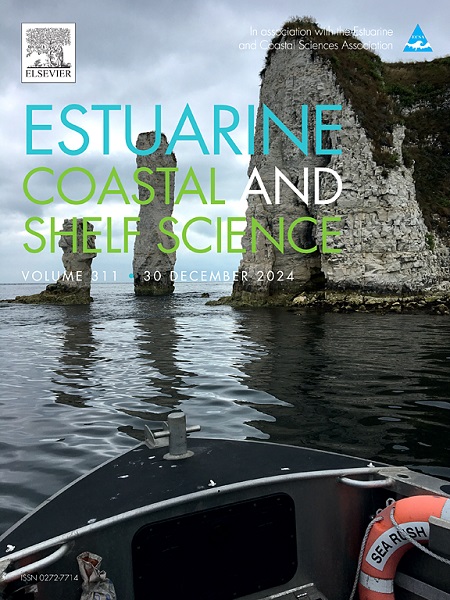加勒比海哥伦比亚热带河口系统海面微层表面活性剂的分布
IF 2.6
3区 地球科学
Q1 MARINE & FRESHWATER BIOLOGY
引用次数: 0
摘要
海洋表面微层是海洋-大气界面(厚度≤1000 μm),在海洋表面普遍存在,其特征是表面活性剂的积累,影响与气候相关的气体(如CO2)的交换。本研究以加勒比海乌拉巴湾(Gulf of urab本文章由计算机程序翻译,如有差异,请以英文原文为准。
Distribution of surfactants in the sea surface microlayer across a tropical estuarine system in Caribbean Colombia
The sea surface microlayer is the ocean–atmosphere interface (≤1000 μm thick), is ubiquitous on the ocean surface, and is characterized by the accumulation of surfactants that influence the exchange of climate-relevant gases, such as CO2. This study on the sea surface microlayer in the Gulf of Urabá, Caribbean Sea, intended to determine the influence of fluvial input on the surfactant concentration distribution and the enrichment factor in a tropical estuarine system. For this purpose, samples were collected in the fluvial and marine zones of the Gulf of Urabá. A glass plate was used to sample the sea surface microlayer. No differences were found in the concentration of surfactants and their enrichment factor between zones. The sea surface microlayer was enriched in surfactants, whose concentration was significantly higher in the sea surface microlayer than in the underlying water. All stations had surfactant concentrations higher than 200 μg Teq L−1, a value above which reductions of up to 23 % in the rate of ocean–atmosphere CO2 transfer was found. About 55 % of the concentrations corresponded to the high regime of surfactants and 28 % to slick zones, and together with the enrichment factor, these were higher than those of other studies conducted in coastal and oceanic areas. Our results offer valuable insights into the ocean–atmosphere interface in tropical biogeochemical cycles and provide new information about the sea surface microlayer in tropical regions where such data are scarce.
求助全文
通过发布文献求助,成功后即可免费获取论文全文。
去求助
来源期刊
CiteScore
5.60
自引率
7.10%
发文量
374
审稿时长
9 months
期刊介绍:
Estuarine, Coastal and Shelf Science is an international multidisciplinary journal devoted to the analysis of saline water phenomena ranging from the outer edge of the continental shelf to the upper limits of the tidal zone. The journal provides a unique forum, unifying the multidisciplinary approaches to the study of the oceanography of estuaries, coastal zones, and continental shelf seas. It features original research papers, review papers and short communications treating such disciplines as zoology, botany, geology, sedimentology, physical oceanography.

 求助内容:
求助内容: 应助结果提醒方式:
应助结果提醒方式:


